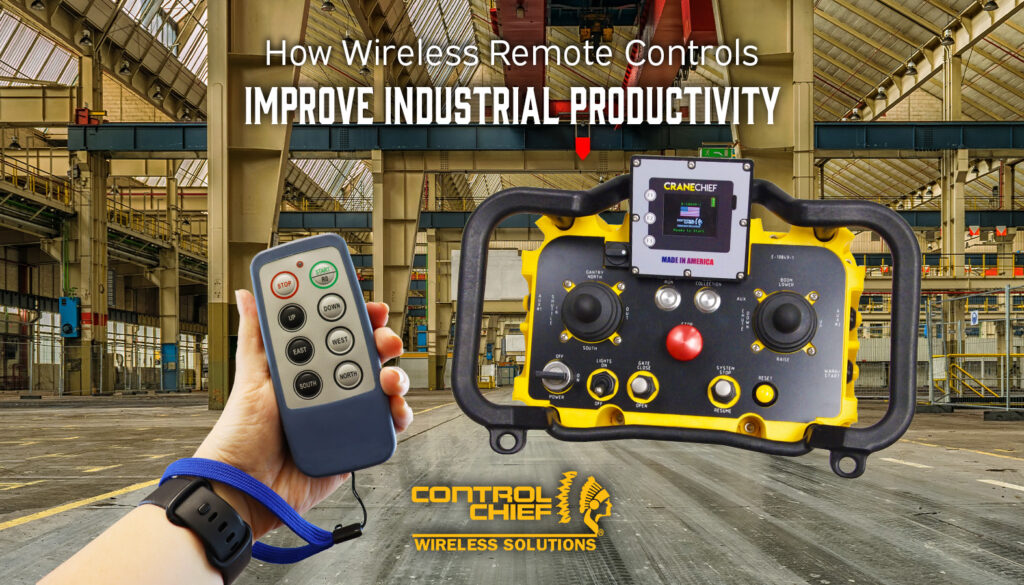How Wireless Crane Remote Controls Boost Industrial Productivity

Productivity is the name of the game. Your industrial environment needs to be if you’d like any chance of keeping up with the competition – or, ideally, gaining a competitive advantage. Wireless crane remote controls improve your industrial productivity and capacity to achieve greatly.
Efficiency and productivity are paramount. You need the right tools for the job. Companies like yours constantly seek those tools to streamline operations, reduce downtime and maximize the output of their workforce.
One technological advancement, in particular, has significantly contributed to these goals: wireless crane remote controls. This innovative solution is transforming how materials are moved in warehouses, construction sites and numerous other industrial settings.
Wireless Crane Remote Controls are Supercharging Productivity in the Industrial Sector. Here’s How.
1. Enhanced Operational Flexibility
The days of being confined to a stuffy crane cab, struggling to achieve precision movement with multi-ton loads, are becoming a thing of the past. Wireless crane remote controls provide operators with unparalleled freedom of movement. Unlike traditional wired pendant controls that essentially tether an operator to a specific workspace, wireless controls allow operators to move around the floor or site freely.
This flexibility enables operators to position themselves optimally for each lift, ensuring better visibility and precision. (Helpful hint: that also greatly improves safety . More on that in just a second.) Whether your team members need to get closer to the load for accurate placement or maintain a safe distance from hazardous materials, wireless controls make it all possible.
2. Improved Visibility & Safety
Another primary benefit of wireless crane remote controls is enhanced visibility. Operators can move to a vantage point that offers the best view of the load and the surrounding area, reducing the likelihood of accidents. (Check out this video of a crane failure dangerously dropping a 75-ton load. You don’t want team members anywhere near a potential disaster like this.)
Improved visibility reduces the need for a spotter, allowing the operator to guide and rig the load independently. This reduces the number of personnel required on-site and also minimizes the risk of trip-and-fall accidents.
3. Eliminating Cable-Related Issues
Old-school wired pendant controls can sometimes become entangled with crane cables, creating operational delays and potential hazards. Fixing entangled cables is like untangling Christmas lights on an industrial scale.
Wireless controls eliminate this issue entirely, ensuring a smooth and uninterrupted workflow. Without the worry of tangled cables, operators can focus solely on the task at hand, leading to increased efficiency and reduced downtime.
4. Crane Operators Don’t Have to Follow the Path of the Load
Another significant advantage of wireless crane remote controls is that operators no longer need to follow the load’s path. With wired pendant controls, operators often must move alongside the crane to keep a stable speed and direction.
Wireless controls allow operators to maintain a safe distance and position themselves strategically, reducing physical strain and enhancing overall safety. And because safety, of course, is your greatest prerogative, you can avoid operator fatigue and the potential risk of accidents.
5. Multi-Frequency Capabilities for Complex Operations
Customized wireless crane remote controls – like our CraneChief™ Remote Control Transmitters – are equipped with multi-frequency capabilities. This allows operators to manage multiple cranes simultaneously without interference. This capacity is particularly beneficial in large industrial settings where numerous cranes must operate at the same time.
The ability to control multiple units efficiently enhances coordination and makes operations much more efficient. Who wouldn’t enjoy more expedient shipping or faster project completion times?
6. Portability & Convenience
Continuing on the path to efficiency, wireless crane remote controls are designed for ease of use and portability. Lightweight and ergonomically designed “bellybox” units can be easily carried or clipped onto a harness, providing operators with convenient access to controls wherever needed.
This portability ensures that operators can respond quickly to changing job site conditions.
7. Increased Precision & Accuracy
Precision crane operations are always critical – for both productivity AND most importantly safety. Operators must maneuver loads through tight spaces while aligning them with exact placement points.
Wireless controls offer a BIG advantage. Operators can move closer to the load without being confined to a crane cab, ensuring precise movements and accurate placements. This advanced capacity for control reduces errors and rework, saving both time and resources.
Boost Your Overall Industrial Productivity with Wireless Crane Remote Controls
The cumulative effect of these benefits is a substantial boost in overall productivity for your industrial workplace, whatever it may be. By enhancing visibility, reducing the need for additional personnel, preventing cable-related issues, and enabling precise control, wireless crane remote controls streamline operations and expedite project timelines.
Wireless crane remote controls are not just a technological innovation. They’re a game-changer for industry. As industries continue to evolve, the adoption of wireless crane remote controls will undoubtedly become more widespread, setting new standards for efficiency and performance in material handling operations.
Embracing this technology is a step towards a safer, more productive (and more profitable future). For more information, contact Control Chief sales manager Mark Childs or industrial sales consultant Nicole Alter here. Or call (814) 362-6811. Let’s work together to create a safer and more productive work environment.
Views: 89






